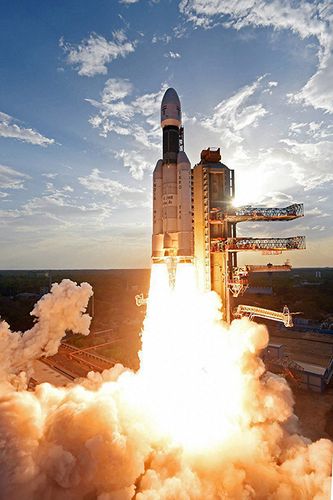 In-house marvel: GSLV Mk III rocket, carrying GSAT-19, takes off from Satish Dhawan Space Centre, Sriharikota | PTI
In-house marvel: GSLV Mk III rocket, carrying GSAT-19, takes off from Satish Dhawan Space Centre, Sriharikota | PTI
Two fat majors. That’s how the successful launch of the GSAT-19 satellite aboard the GSLV Mk III rocket can be summed up. India successfully launched the heaviest satellite (3,136kg) aboard the biggest ever rocket that Indian Space Research Organisation (ISRO) has made. As the rocket shot off Second Launch Pad at Satish Dhawan Space Centre in Sriharikota on June 5 and the satellite reached its destined orbit, ISRO scientists heaved a sigh of relief. It was the culmination of 25 years’ work, 13 of which were in developing the cryogenic engine.
Let’s first look at what makes the rocket special. It is heavy, capable of ferrying payloads of four tonnes into the Geosynchronous Transfer Orbit, where the GSAT-19 was sent, and ten tonnes into a Lower Earth Orbit, where, hopefully within a decade, ISRO’s human space flight should head.
Big is not its only qualification. GSLV Mk III’s engine has three fuel components—liquid, solid and cryogenic. The last stage, the C25, has cryogenic propellants stored at low temperatures and its ignition starts five minutes after the launch, to be able to give a 20-tonne thrust to take the satellite to its destination. All three stages—solid S200, liquid L110 and C25—are new developments, but the C25 is a marvel of indigenous technology. ISRO scientists say no country would want to share this technology, and India is among the few in the world to have developed it, all in-house. A lesser written-about success is that of the 199 tests done on this rocket, all but one were successful at the first time itself.
ISRO also developed a new technology to reduce acoustic vibrations at take-off, which cause damage to the rocket and launch pad. Six hundred tonnes of water were splashed on the launch pad to douse flames just as the rocket took off, to keep acoustic vibrations within acceptable levels. The water facility is the new showpiece at the Satish Dhawan Space Centre. Also, ISRO developed a new facility for making solid propellant, which will now be used for other rockets, too.
This was the Mk III’s first development flight. It needs another such flight, scheduled for next year, to be considered a regular vehicle for heavy launches.
The satellite, GSAT-19, is a first in a series of geostationary communication satellites that ISRO is calling a gamechanger in the field of communications. “This alone will do the work of six previous communication satellites. It has eight beams covering India, where previously one beam was there, and has a capacity of five gigabits per second [previous satellites just had two gigabits/sec],” said Tapan Misra, director, Space Applications Centre. “GSAT-11 [2017] will have 13 gigabits per second and GSAT-20 [2018] will have a capacity of 70 gigabits per second. In two years, internet connectivity as we know it will scale up phenomenally.” .
GSAT-19 is also testing a slew of indigenously developed technologies that will be the mainstay of ISRO’s communication satellite for at least a decade. It has ultra triple junction solar cells that generate 4,500 watts of electrical power, and sun, earth and star sensors and gyroscopes for orientation reference. It carries Ka/Ku band high throughput communication transponders and a geostationary radiation spectrometer (GRASP) to monitor and study the nature of charged particles and the influence of space radiation on satellites. It carries lithium-operated batteries that could some day find use in powering eco-friendly vehicles on earth, too.
ISRO, which has boasted about how cost effective its technology is, has, for the first time, decided not to reveal the costs. Let’s keep the competition guessing, joked its chairperson, A.S. Kiran Kumar.






